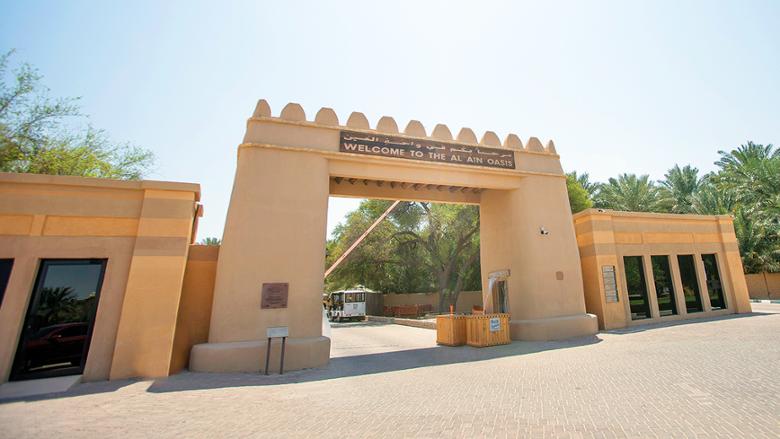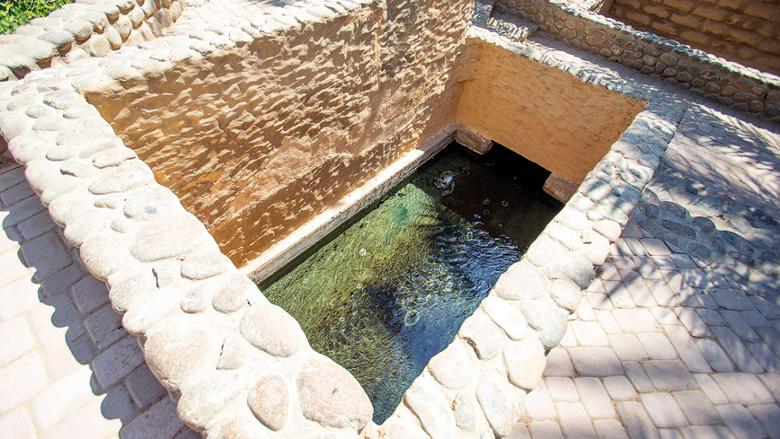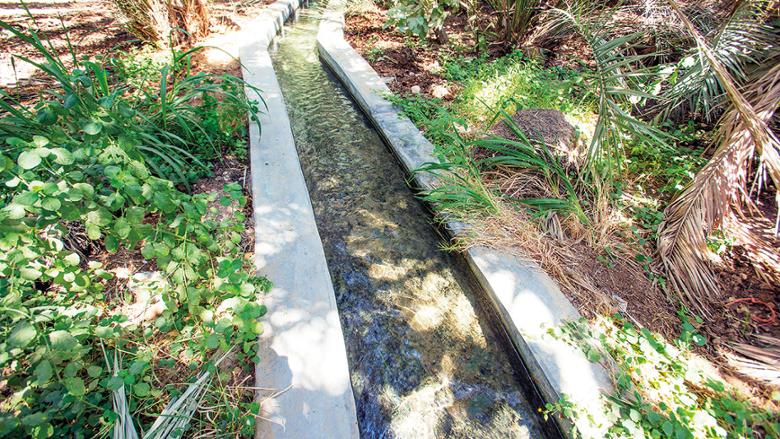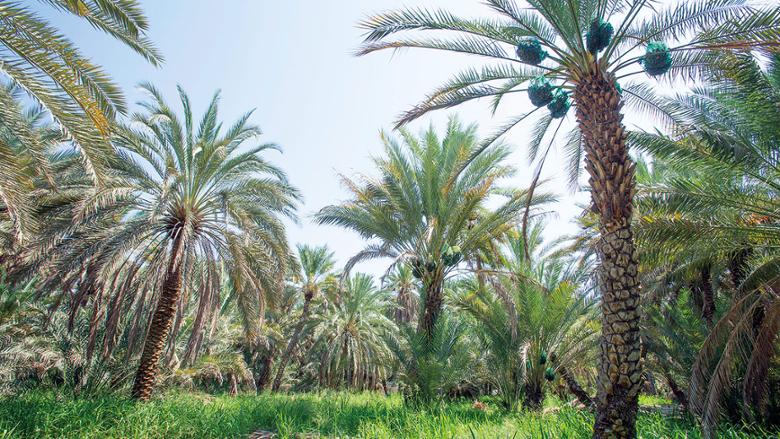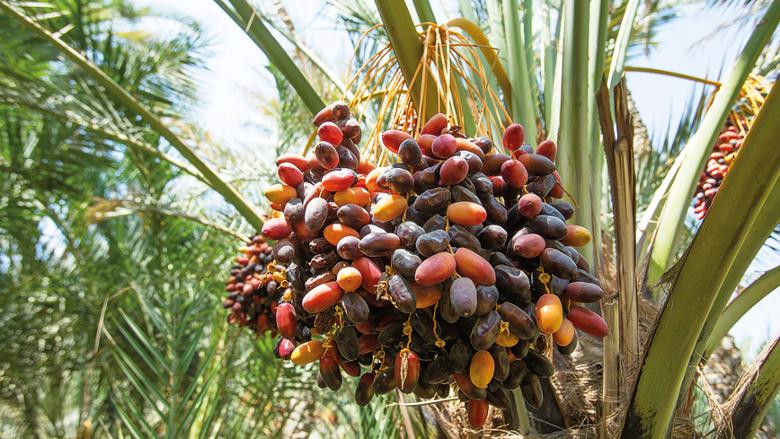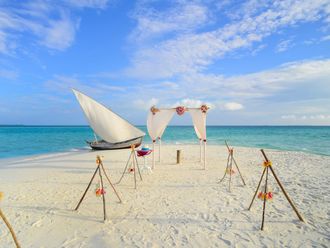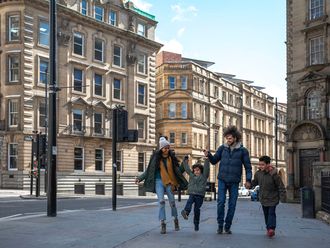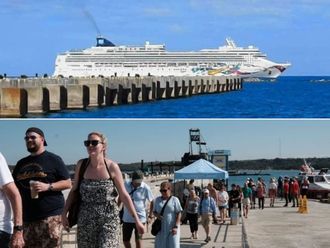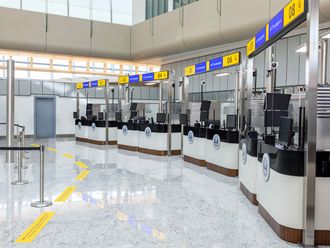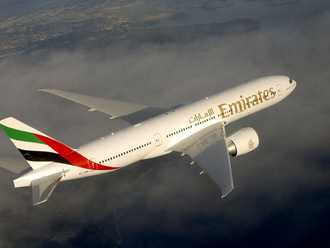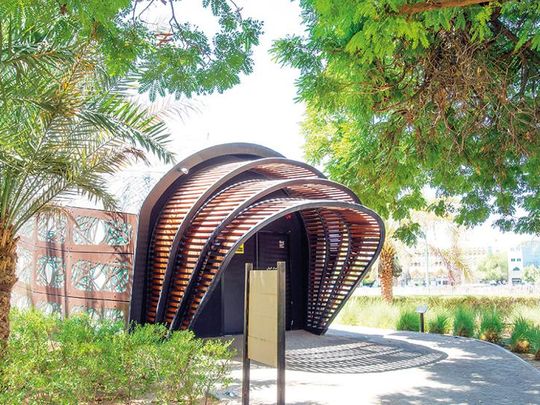
Walking under the shade of the thick canopy of leafy date palms, we are shielded comfortably from the glare of the blazing sun even though temperatures outside are hovering around the 40-degree C mark. Stretched before us, covering 1,200 hectares, lie the verdant green date palm plantations that make up the Al Ain Oasis, located right in the heart of the city in the Al Mutawa area around 90 miles east of Abu Dhabi.
There is a sense of peace and quiet all around us as we stand amidst the nearly 150,000 palm trees and hundreds of other fruit trees that make up this magnificent oasis. Contrasting with the green spiny leaves and brown, rugged trunks of the date palms are the reddish-brown fruits hanging low on the trees while up above, shades of blue are visible through the dense foliage.
This is indeed a haven of tranquillity and the silence is only broken by the pleasing sounds of nature. We hear the chirping of the birds, listen to the rustle of the palm fronds, and watch how the trees sieve the bright sunlight, creating interesting patterns as it filters down to the ground. With every step we take further into the walled date palm gardens, the sense of magic and wonder only grows and, before long, we seem to have left the sounds of the city far behind.
[Al Ain’s Al Jahili Fort is an emblem of power and innovation]
Contrary to what one might imagine, an oasis is not just a small palm grove in the middle of the desert where humans settled and practised cultivation. ‘An oasis landscape constitutes an entire desert environment,’ explains our official guide at Al Ain Oasis. ‘It also incorporates architecture, shared knowledge, social interaction and traditional practices that were vital for the survival of the people who inhabited these lands.’
What makes the place all the more attractive is that unlike all the modern developments that have propelled the UAE into international limelight, the Al Ain Oasis stands as a vestige of its glorious past and allows us to conjure an image of life in the region thousands of years ago.
Al Ain, situated at the crossroads of the ancient land routes between Oman, the Arabian Peninsula, the Arabian Gulf and Mesopotamia, is one of the world’s oldest continually inhabited settlements, and the oasis we are standing in has a 3,000-year-old history, explains our guide. ‘Al Ain Oasis is the largest of the six oases in Al Ain and is one among the four cultural sites recognised by Unesco in 2011 as a World Heritage Site. It bears testimony to the development of successive prehistoric cultures in a desert region dating from the Neolithic period and is also a symbol of the resilience of the Bedouin people who chose to live here and embrace the harsh desert environment.
‘What we see before us,’ says our guide as he leads us further into the farm, ‘offers an impressive insight into the history and lives of our ancestors. It tells us how they maintained a sustainable and positive relationship with the desert and the environment; and how they used their knowledge to establish a sustainable water management and irrigation system known as falaj to create a green and fertile environment.’
Today, the Al Ain Oasis comprises around 550 privately operating farms on widespread plantations. ‘Some of the trees have been standing for at least a hundred years,’ he says. ‘More than 120 varieties of date palms are grown here in addition to a range of fruit trees including mango, lemon, banana, olives, figs, and many more.’
Falaj... up close
We follow the sounds of the trickle of water as we make our way through the shaded walkway to witness how the 3,000-year-old traditional falaj irrigation system continues to water the entire oasis even today. ‘Since the Iron Age, people living here have relied on the falaj to bring fresh spring water from the nearby Hajar mountain range, several kilometres away,’ explains our guide. ‘This method of irrigation is made up of a clever system of underground and/or surface channels that also prevent loss by evaporation. Water is tapped either from mother wells sunk down to the water table or by digging an underground tunnel from the source of an aquifer situated under higher land or mountains. The tunnel gradually slopes down all the way to low-lying oases where it surfaces.’
We reach Shari’a, the place where the water reaches the surface from the underground channels and which is also the place where the community met for all activities connected with water. ‘It is from here that the water division was controlled in accordance with a complex water allocation plan and distributed to the various owners of the farms – a system still in practise today,’ he explains. ‘This is done by blocking channels to direct the water to the required area.’
He then leads us into an adjoining farm where we notice a series of water channels crisscrossing flourishing date palms. The channels have been cemented now for durability. As we listen to the constant gurgle of crystal clear water streaming through in a steady flow, it is easy to understand why the region has been named Al Ain, which means ‘spring’ in Arabic.
Engineering marvel
The falaj is an engineering marvel and the oldest in the region is the one excavated in the nearby Hili Archaeological Park, explains our guide. ‘The falaj system has been used in North Africa, Spain, Sicily, Greece, Iraq, Afghanistan, and other places in Central Asia and is believed to have been invented at the beginning of the first millennium BCE, or about 3,000 years ago.’
However, irrigation was not the only benefit of the falaj, he asserts. ‘While the economy flourished because of increased agriculture, it also had a cultural impact as it brought people together to the Shari’a thus sustaining the social system and allowing the community structure to exist and continue.’
Over the course of several millennia, the water that flowed from the nearby Wadi Sarooj deposited fine silt and clay to the oasis area. These sediments, a natural process of weathering of the mountain rocks, have high water retention capabilities, thereby ensuring continuous cultivation. The nature and high quality of this soil is what led to the presence of the oasis at this location, says our guide.
‘Since water was a precious resource, the oasis was fortified by watch towers to safeguard both the falaj system and oasis from potential threats. People generally dwelt on the outer edge of the oasis as the land was used solely for cultivation.’
Some of the main varieties of dates grown in the Al Ain oasis are naghal, khunaizi, khalas, jaberi, fardh and hilali, points out our guide.
While the fruit of the date palm was a mainstay of local nutrition, and its cultivation ensured a dependable supply of high-energy food, almost every part of this valuable tree has been made use of for centuries in the region, he says.
‘The trunks of felled palms provided the main framework for traditional houses while the fronds of the leaves were repurposed into bags, baskets, mats, fans, and several other household items. Even today, this tradition is in practice thus helping preserve ancient Emirati handicraft techniques.’

Soaked, dried and powdered date stones were used as animal feed while certain parts of the palm tree were also used for medicinal and cosmetic purposes.
Strolling along the meandering walkways, we notice a number of old mosques that were part of the oasis since ages, one of which dates back to at least 200 years.
Radiating from the green heart of the Al Ain Oasis you can also find historic buildings featuring traditional architectural elements. On its west lies the Sheikh Zayed Palace Museum, the former residence of the UAE’s Founding Father. In the north is the souq, which once was the city’s main market while on its east is the Al Murabba Fort, which originally served as a watch tower.
Following the recognition of the Al Ain Oasis as a World Heritage Site and to open out the site to visitors, several construction works were undertaken a few years ago. ‘These were all low environment impact structures that also remained faithful to the architectural style of the existing structures,’ he says.
On our way back to the main gate, we come across a refreshment outlet fitted out entirely with various parts of felled date palm trees. Trunks have been hollowed out to make furniture and these have also been cut and shaped to form the roof beams.
The Al Ain date palm oasis is also one of a growing number of ecosystems in the UAE that have been formally recognised by the United Nation’s Food and Agriculture Organisation as a Globally Important Agricultural Heritage System, he adds.
An important site
‘The oasis is deemed as globally significant because it is an in-situ repository of date palm genetic resources. As home to the falaj irrigation systems, it is also a testament to human agricultural and technological ingenuity in hard environmental conditions.’
It is the oases that have shaped the landscape of the desert, he adds. ‘These lush green havens portray the cultural transformation that occurred in the transition from nomadic to settled communities around the oasis and are an indicator of the first step of the city’s development before the discovery of oil in the UAE in the 1960s. There is an entire life and culture prevalent here and it is this heritage that we seek to showcase to the visitors.’
Our guide leads us on to the Oasis Garden, which showcases the complex three tiers or levels of the oasis ecosystem. The first tier features ground crops that do not require a lot of water and thrive under the shade of the palm tree. Some plants, such as henna and aloe vera, have been cultivated for therapeutic use while Bristle Grass prevents dunes from advancing.
The second tier consists of orchards or fruit trees including figs, pomegranates, lemons, bananas and olive trees. ‘Sugarcane, which has been planted at the edge of the garden, was fundamental to the history of the Arab farming industry,’ he explains.
The final tier consists of tall plant foliage that helps create shade thereby enabling other plants to grow in the desert. ‘In an oasis, this is primarily the function of the palm tree but as a symbolic representation, we have included Neem from India, Moringa from Africa and the valuable Frankincense tree from Oman. The Oasis Garden is an example of how an alliance between species of plants generates life in extreme environments.’
It is at the Eco Centre near the West Gate entrance that we learn more about the history of oases and the culture and traditions prevalent here. Through interactive 3D installations, touch-screen enabled educative games, and short videos, we also learn more about the date palm itself.
The Eco Centre is built in honeycomb style architecture and combines traditional and innovative technology to blend its organic form into the landscape. The panel patterns evoke the subtle interplay of light peering through the palm treetops.
We then visit the Miniature Oasis, a small-scale reconstruction showing the elements, water distribution and architecture of the Al Ain Oasis. There are scale models of the existing historic buildings and the falaj network that carries water to the gardens.
Another West Gate exhibit is that of the watercourse system, or falaj, and demonstrates how farmers have worked with the delicate ecosystem for generations to sustain the oasis. As we battle global warming and climate extremes today across the planet, there is truly much to learn from this unique ecosystem that has survived in a hostile desert environment for millennia.
KNOW BEFORE YOU GO
• Free entry
• Timings: Daily 9am to 5pm
• Cafes and shops: Daily 12 noon onwards
• Vehicles cannot be taken inside. Cycles and golf carts can be hired at the entrance.
• There are several entrances to the Al Ain Oasis. The West Gate is the main entrance and this is where the Eco Centre, Oasis Garden and Miniature Oasis are located.
• Food outlets offer refreshments and traditional Emirati dishes.


